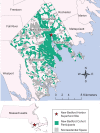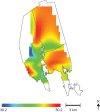Spatial Variability in ADHD-Related Behaviors Among Children Born to Mothers Residing Near the New Bedford Harbor Superfund Site
- PMID: 28444119
- PMCID: PMC5430935
- DOI: 10.1093/aje/kww208
Spatial Variability in ADHD-Related Behaviors Among Children Born to Mothers Residing Near the New Bedford Harbor Superfund Site
Abstract
Attention-deficit/hyperactivity disorder (ADHD) has an uncertain etiology, with potential contributions from different risk factors such as prenatal environmental exposure to organochlorines and metals, social risk factors, and genetics. The degree to which geographic variability in ADHD is independent of, or explained by, risk factors may provide etiological insight. We investigated determinants of geographic variation in ADHD-related behaviors among children living near the polychlorinated biphenyl-contaminated New Bedford Harbor (NBH) Superfund site in Massachusetts. Participants were 573 children recruited at birth (1993-1998) who were born to mothers residing near the NBH site. We assessed ADHD-related behaviors at age 8 years using Conners' Teacher Rating Scale-Revised: Long Version. Adjusted generalized additive models were used to smooth the association of pregnancy residence with ADHD-related behaviors and assess whether prenatal organochlorine or metal exposures, sociodemographic factors, or other factors explained spatial patterns. Models that adjusted for child's age and sex displayed significantly increased ADHD-related behavior among children whose mothers resided west of the NBH site during pregnancy. These spatial patterns persisted after adjusting for prenatal exposure to organochlorines and metals but were no longer significant after controlling for sociodemographic factors. The findings underscore the value of spatial analysis in identifying high-risk subpopulations and evaluating candidate risk factors.
Keywords: attention-deficit/hyperactivity disorder; environmental exposures; geographic analysis; sociodemographic risk factors.
© The Author 2017. Published by Oxford University Press on behalf of the Johns Hopkins Bloomberg School of Public Health.
Figures



Similar articles
-
Prenatal organochlorine exposure and behaviors associated with attention deficit hyperactivity disorder in school-aged children.Am J Epidemiol. 2010 Mar 1;171(5):593-601. doi: 10.1093/aje/kwp427. Epub 2010 Jan 27. Am J Epidemiol. 2010. PMID: 20106937 Free PMC article.
-
Assessing the relation of chemical and non-chemical stressors with risk-taking related behavior and adaptive individual attributes among adolescents living near the New Bedford Harbor Superfund site.Environ Int. 2021 Jan;146:106199. doi: 10.1016/j.envint.2020.106199. Epub 2020 Oct 27. Environ Int. 2021. PMID: 33126063 Free PMC article.
-
Measured Prenatal and Estimated Postnatal Levels of Polychlorinated Biphenyls (PCBs) and ADHD-Related Behaviors in 8-Year-Old Children.Environ Health Perspect. 2015 Sep;123(9):888-94. doi: 10.1289/ehp.1408084. Epub 2015 Mar 13. Environ Health Perspect. 2015. PMID: 25769180 Free PMC article.
-
Review of current evidence on the impact of pesticides, polychlorinated biphenyls and selected metals on attention deficit / hyperactivity disorder in children.Int J Occup Med Environ Health. 2013 Mar;26(1):16-38. doi: 10.2478/s13382-013-0073-7. Epub 2013 Mar 22. Int J Occup Med Environ Health. 2013. PMID: 23526196 Review.
-
Lead and PCBs as risk factors for attention deficit/hyperactivity disorder.Environ Health Perspect. 2010 Dec;118(12):1654-67. doi: 10.1289/ehp.0901852. Epub 2010 Sep 9. Environ Health Perspect. 2010. PMID: 20829149 Free PMC article. Review.
Cited by
-
Mapping associations of polygenic scores with autistic and ADHD traits in a single city region.J Child Psychol Psychiatry. 2025 Feb;66(2):202-213. doi: 10.1111/jcpp.14047. Epub 2024 Aug 14. J Child Psychol Psychiatry. 2025. PMID: 39143033 Free PMC article.
-
Spatial disparities of HIV prevalence in South Africa. Do sociodemographic, behavioral, and biological factors explain this spatial variability?Front Public Health. 2022 Nov 11;10:994277. doi: 10.3389/fpubh.2022.994277. eCollection 2022. Front Public Health. 2022. PMID: 36438270 Free PMC article.
-
Using Birth Cohort Data to Estimate Prenatal Chemical Exposures for All Births around the New Bedford Harbor Superfund Site in Massachusetts.Environ Health Perspect. 2019 Aug;127(8):87008. doi: 10.1289/EHP4849. Epub 2019 Aug 26. Environ Health Perspect. 2019. PMID: 31449464 Free PMC article.
-
Environmental and Household-Based Spatial Risks for Tungiasis in an Endemic Area of Coastal Kenya.Trop Med Infect Dis. 2021 Dec 23;7(1):2. doi: 10.3390/tropicalmed7010002. Trop Med Infect Dis. 2021. PMID: 35051118 Free PMC article.
-
Epidemiologically-informed cumulative risk hypertension models simulating the impact of changes in metal, organochlorine, and non-chemical exposures in an environmental justice community.Environ Res. 2019 Sep;176:108544. doi: 10.1016/j.envres.2019.108544. Epub 2019 Jun 20. Environ Res. 2019. PMID: 31271923 Free PMC article.
References
-
- Faraone SV, Doyle AE. The nature and heritability of attention-deficit/hyperactivity disorder. Child Adolesc Psychiatr Clin N Am. 2001;10(2):299–316. - PubMed
-
- Bellinger D, Leviton A, Allred E, et al. . Pre- and postnatal lead exposure and behavior problems in school-aged children. Environ Res. 1994;66(1):12–30. - PubMed
-
- Biederman J. Attention-deficit/hyperactivity disorder: a selective overview. Biol Psychiatry. 2005;57(11):1215–1220. - PubMed
-
- Millichap JG. Etiologic classification of attention deficit/hyperactivity disorder. Pediatrics. 2008;121(2):e358–e365. - PubMed
-
- Korrick SA, Altshul LM, Tolbert PE, et al. . Measurement of PCBs, DDE, and hexachlorobenzene in cord blood from infants born in towns adjacent to a PCB-contaminated waste site. J Expo Anal Environ Epidemiol. 2000;10(6):743–754. - PubMed
Publication types
MeSH terms
Substances
Grants and funding
LinkOut - more resources
Full Text Sources
Other Literature Sources
Medical

